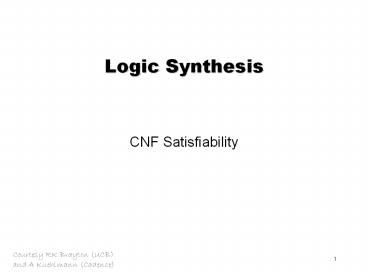Logic Synthesis PowerPoint PPT Presentation
Title: Logic Synthesis
1
Logic Synthesis
- CNF Satisfiability
2
CNF Formulas
- Product of Sum (POS) representation of Boolean
function - Describes solution using a set of constraints
- very handy in many applications because new
constraints can just be added to the list of
existing constraints - very common in AI community
- Example
- j
- ( ab c)
- (a b c)
- ( abc)
- ( a b c)
- SAT on CNF (POS) Û Tautology on DNF (SOP)
3
Circuit versus CNF
- Naive conversion of circuit to CNF
- multiply out expressions of circuit until two
level structure - Example y x1Å x2 Å x2 Å ... Å xn (Parity
function) - circuit size is linear in the number of variables
- Å
- generated chess-board Karnaugh map
- CNF (or DNF) formula has 2n-1 terms (exponential
in the vars) - Better approach
- introduce one variable per circuit vertex
- formulate the circuit as a conjunction of
constraints imposed on the vertex values by the
gates - uses more variables but size of formula is linear
in the size of the circuit
4
Example
Single gate
a
(ab c)(ac)(bc)
c
b
Circuit of connected gates
(124)(14)(24) (235)(25)(35) (23
6)(26)(36) (457)(47)(57) (568)(5
8)(68) (789)(79)(89) (9)
Justify to 0
5
Basic Case Splitting Algorithm
a
b
b
c
c
c
d
d
d
d
d
Source Karem A. Sakallah, Univ. of Michigan
6
Implications in CNF
- Implications in a CNF formula are caused by unit
clauses - unit clause is a CNF term for which all variables
except one are assigned - the value of that clause can be implied
immediately - Example (abc) (a0)(b1)Þ(c1)
- No implications in circuit
- All clauses satisfied
- Not all satisfies (How do we avoid exploring that
part of the circuit?)
(abc)(ac)(bc)
7
Example
a
(ab c) (ac) (bc)
c
b
Implications
8
Case Splitting with Implications
a
b
b
c
c
Source Karem A. Sakallah, Univ. of Michigan
9
Implementation
- Clauses are stores in array
- Track sensitivity of clauses for changes
- all literals but one assigned -gt implication
- all literals but two assigned -gt clause is
sensitive to a change of either literal - all other clauses are insensitive and do not need
to be observed - Learning
- learned implications are added to the CNF formula
as additional clauses - limit the size of the clause
- limit the lifetime of a clause, will be removed
after some time - Non-chronological back-tracking
- similar to circuit case
10
Conflict-based Learning
a
ab j ß j (a b)
a j ß j (a)
bc j ß j (b c)
b
b
c
Source Karem A. Sakallah, Univ. of Michigan
11
Conflict-based Learning
- Important detail for cut selection
- During implication processing, record decision
level for each implication - At conflict, select earliest cut such that
exactly one node of the implication graph lies on
current decision level - Either decision variable itself
- Or UIP (unique implication point) that
represents a dominator node in conflict graph - By selecting such cut, implication processing
will automatically flip decision variable (or UIP
variable) to its complementary value
12
Further Improvements
- Random restarts
- stop after a given number of backtracks
- start search again with modified ordering
heuristic - keep learned structures !!!
- very effective for satisfiable formulas but often
also effective for unsat formulas - Learning of equivalence relations
- (a Þ b) Ù (b Þ a) Þ (a b)
- very powerful for formal equivalence checking

